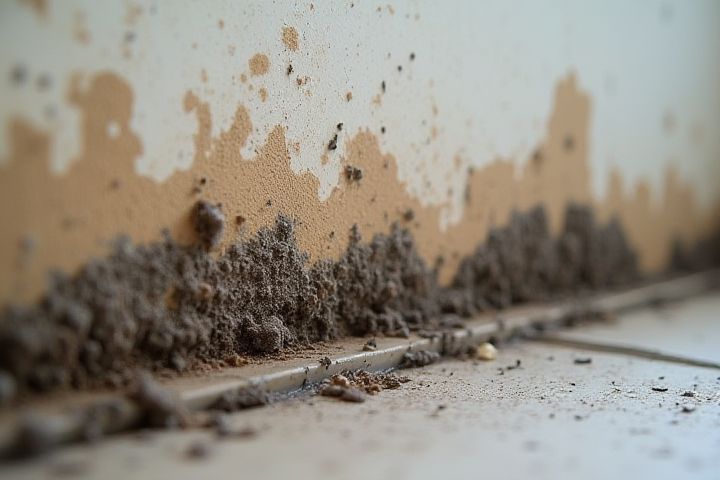
Begin your mold inspection by examining areas prone to moisture, such as bathrooms, kitchens, and basements, where dampness often leads to mold growth. Look for visible signs of mold, including black or green spots on walls, ceilings, and around windows, as well as any water stains or discoloration. Use a moisture meter to measure the humidity levels in each area, as mold thrives in environments with humidity levels above 60%. Pay attention to any musty odors, as these can indicate hidden mold issues within walls or under flooring. Lastly, check for leaks in plumbing, roofing, or windows, which can create an environment conducive to mold proliferation and require immediate attention.
How To Inspect A House For Mold
Check for musty odors.
Inspecting a house for mold begins with checking for musty odors, which often indicate the presence of moisture problems or mold growth. These odors can be especially potent in areas with poor ventilation, such as basements, bathrooms, and attics. Pay close attention to hidden spaces, such as behind appliances, under sinks, and within wall cavities, where mold may thrive away from sight. If you detect a persistent musty smell, consider using a professional mold inspection service to assess the extent of potential mold issues in your home.
Look for visible mold spots.
Inspecting a house for mold requires a keen eye for visible mold spots, which typically appear as dark, discolored patches on walls, ceilings, and floors. Check areas prone to moisture, such as bathrooms, basements, and around windows, where mold thrives due to high humidity levels. Pay close attention to hidden corners and behind furniture, as mold can grow in places that are not frequently accessed. If you spot a musty odor accompanying these visible signs, it may indicate a more extensive mold issue that could require professional remediation.
Monitor humidity levels.
Monitoring humidity levels in your home is crucial for mold inspection, as mold thrives in humid environments. A humidity level of 30% to 50% is ideal for preventing mold growth. Use a hygrometer to regularly check the humidity in various areas, particularly basements and bathrooms where moisture is likely to accumulate. If you find humidity levels exceeding 60%, consider using dehumidifiers or improving ventilation to reduce moisture and inhibit mold development.
Inspect water-damaged areas.
Inspect water-damaged areas thoroughly, as they are prime candidates for mold growth. Look for signs of moisture, such as stains on walls, ceilings, or floors, particularly in places like bathrooms, basements, and around windows. Use a moisture meter to measure levels above 16%, indicating potential mold-friendly conditions. Pay close attention to materials like drywall, wood, and carpets, which can harbor hidden spores if they have been affected by water.
Examine HVAC systems.
Inspecting HVAC systems is crucial in identifying potential mold issues within a house. Check for visible signs of mold growth, especially in ducts, filters, and drip pans, as stagnant moisture often fosters mold development. Ensure that the HVAC system operates efficiently by examining its maintenance history; systems poorly maintained are more prone to mold infestations due to accumulated dust and humidity. Regularly replacing filters every 1-3 months can also help mitigate mold risk and improve air quality in your home.
Check around windows and doors.
Inspect around windows and doors for mold by examining the caulking and weather stripping for any signs of deterioration or water damage. Pay close attention to corners and edges, where moisture can accumulate, as these areas are prime spots for mold growth. Using a flashlight, look for any discoloration or black spots that could indicate mold presence. Remember, addressing any leaks or water infiltration promptly can help prevent mold development in these vulnerable areas.
Look in bathrooms and kitchens.
Inspecting for mold in bathrooms and kitchens requires careful observation of high-moisture areas. Check under sinks, around bathtubs, and behind toilets, where leaks can often go unnoticed, and mold can thrive if humidity remains consistently high. Pay attention to grout lines, caulking, and any visible stains on walls or ceilings--black, green, or white specks may indicate mold growth. Ensure ventilation systems are functioning properly, as inadequate airflow can increase moisture levels, making these spaces more susceptible to mold infestations.
Examine basements and crawl spaces.
Examine basements and crawl spaces for mold by checking for dampness, water stains, or musty odors, which are indicators of potential mold growth. Look for visible mold on walls, floors, and structural supports, especially in areas with poor ventilation or moisture accumulation. Utilize a moisture meter to detect hidden dampness in wood and concrete, as mold thrives in environments with high humidity levels. Remember to inspect insulation materials and HVAC systems, as they can harbor mold spores and contribute to indoor air quality issues.
Inspect attics and roofs.
When inspecting a house for mold, pay close attention to attics and roofs, as these areas often harbor moisture due to poor ventilation or leaks. Using a flashlight, check for dark spots, discoloration, or a musty odor that may indicate mold growth on wooden beams and insulation. Look for any signs of water damage, such as stains or peeling paint, which can also suggest a moisture problem that encourages mold proliferation. Ensure that ventilation systems are functioning properly, helping to reduce humidity levels that contribute to mold development in these hidden spaces.
Consider professional testing.
Consider professional testing to accurately assess mold presence in your home, as experts utilize specialized equipment that can detect mold spores invisible to the naked eye. Many professionals conduct surface sampling, air quality testing, and moisture assessments, which are essential for identifying potential mold issues in hidden areas. Investing in mold inspection services can cost between $300 and $500, but it can save thousands in potential remediation costs if mold growth goes unchecked. Prioritize hiring certified mold inspectors who follow guidelines from organizations like the Environmental Protection Agency (EPA) to ensure comprehensive evaluations and safety protocols.
